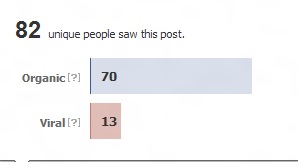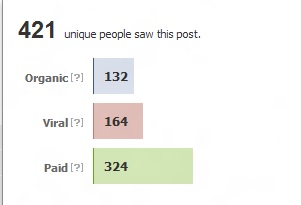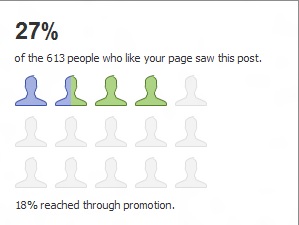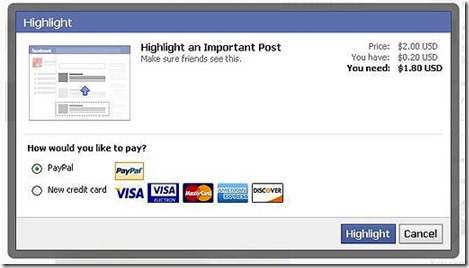Facebook’s Edgerank algorithm—the formula used to determine the order content appears in a given newsfeed based on which content is deemed most relevant to that user—may make the Facebook experience more seamless for casual browsers, but it’s a challenge for businesses that harness the social media platform as part of a marketing strategy. After all, thanks to Edgerank, each post on Facebook only makes it onto the newsfeed of about 12-17% of its fans. The fans that do see it are more likely to be those that have already chosen to visit your page, or that regularly interact with your posts. Edgerank’s feedback-loop effect makes it harder than ever to reach and engage consumers that don’t self-select your business’s content.
To counter those daunting odds, Facebook recently introduced a new service allowing business pages with greater than 400 “likes” to pay a fee to promote individual posts. This new feature allows a page owner to select a single post, which could be a status update, photo, video, question, or offer, and pay a premium to increase the reach for that post beyond the circle of fans that are already engaged with your content. Not only that, but promoted posts are supposedly more likely to be seen in the newsfeeds of friends of fans, too.
Promoted posts have a one-time, pre-set budget that remains in place for the life of the post. While setting up a promoted post, you will be asked to choose a budget from a suite of options that includes the post’s estimated reach at each payment level. The promotion can be suspended or stopped at any time regardless of whether your maximum budget has been used. Promoted posts do have some targeting capabilities, including geographical location and language, but these can only be applied to posts that are less than three days old.
Sounds Great—but Do They Work?
I set out to test the promoted posts feature on my blog’s fan page (which has 613 fans) to see how it performed versus a normal, “organic” post. I’d recently created a page on my blog that consists of a dedicated list of available educational events and conferences for automotive dealers. I shared this blog page via a status update on May 23rd, prior to the launch of Promoted Posts. The post performed as expected, reaching roughly 13% of my page’s fans with a marginal viral reach (a measure of how many impressions came from non-fans who encountered the post because a fan of the page shared or interacted with the post).
Keep in mind that my Facebook page isn’t particularly active, nor do I put too much effort into engaging my fans, which limits the reach of posts. I mainly use the page to post blog articles, so I don’t expect high engagement, but these statistics are in line with the average reach reported by others.
On June 2, I decided to test out the new Promoted Posts feature. Upon creating the new post, the only option presented to me was to pay $5 to reach an estimated 300 people.
The post I promoted was essentially the same as the previous one – a status update which included an external link to the same page on my blog. I did no other social media promotion at all for this post and let it run for the full three days.
Here were the results:
As you can see, the post exceeded the estimated paid reach (with 324 rather than 300 paid impressions), and it also reached 1200% more non-fans (13 vs. 164) via viral sharing, substantially increasing exposure to my fans’ social networks. Organic displays also increased by almost double (70 vs. 132). The promoted post didn’t increase engagement but, the post itself wasn’t really designed to encourage engagement. I also didn’t see a noticeable difference in traffic to the external page on my blog, with the average number of daily visitors to that specific page remaining roughly the same.
Two interesting side notes: First, Facebook defines paid results as “the number of people who saw your page post in an Ad or Sponsored Story.” But when signing up for the service, Facebook never mentioned that my promoted post could potentially be displayed via an Ad (on the right of the newsfeed) versus as a Sponsored Story (within the newsfeed itself). In my estimation, Ads constitute weaker exposure than Sponsored Stories, but I have to assume that at least some of the paid exposure for my promoted post came via Ads.
Second, as mentioned previously, I was initially only given the option to reach 300 people for $5. However, when I looked into promoting another post following my initial trial, I was given a second option to reach 700 people for $10, as well. This tells me that Facebook underestimated the results they could deliver.
Are Promoted Posts for You?
As in any form of advertisement, you must have clearly defined goals before spending any money. Here are some questions you should ask yourself before making a decision one way or another regarding promoted posts.
1. How large is your page’s fan base? Keep in mind that the larger your fan base, the more potential reach each promoted post will have, which will result in a higher upfront cost.
2. Are these actual customers, or are they a random assortment of individuals who were collected in an effort to grow the number of fans at all costs? I consider fans to be relevant if they are potential or existing customers who could realistically do business with you—whether that’s via sales, service, or parts—and whose social networks will, in all likelihood, include more relevant people. In the case of dealerships, for example, it does you no good to increase exposure to people outside your PMA, vendors, or anyone else who doesn’t have the ability to spend money with you. Note, however, that the geo-targeting option does allow you to more efficiently reach relevant fans.
3. What is your goal for promoting a particular post? Is it to increase engagement? Increase exposure for an offer or event? Share important information with your fans? Lead people to an external website or conversion page?
In my opinion, promoting a post just for the sake of promoting it is ill-advised. If you have clear goals in mind, you should be able to accurately track whether your money was spent wisely. Did you actually increase engagement, and was that engagement by new people rather than those who already regularly engage with you? Did more people take advantage of your offer? Did you receive more traffic (via Facebook) to the external link you included in your post?
If you’ve built your fan page organically via your website, in-store signage, or via inclusion in other marketing channels, I could see a promoted post helping to jumpstart your page by potentially increasing your fans via increased exposure to THEIR networks. Keep in mind that the majority of the people you will be reaching already like your page so, in my opinion, the greatest potential of Facebook Promoted Posts is in its ability to extend your exposure beyond your fans and into their social networks.
That being said, a well-thought-out promoted post with clearly defined goals has the potential to increase reach and revenues—all at a relatively low cost.
[Article originally published in the June 2012 issue of the 3 Birds Marketing e-newsletter]




